Sunday, June 26th
4pm
It’s the last Sunday in June, and the Spirit of Rathlin ferry has just pulled away from Ballycastle pier in Co Antrim. The sky is furious and messy; mostly fast-changing clouds of charcoal grey. It dumps so much water in the general area that I lose sight of Rathlin during the 40-minute crossing; hidden as it is for much of the crossing under a foggy mass of undulating rain.
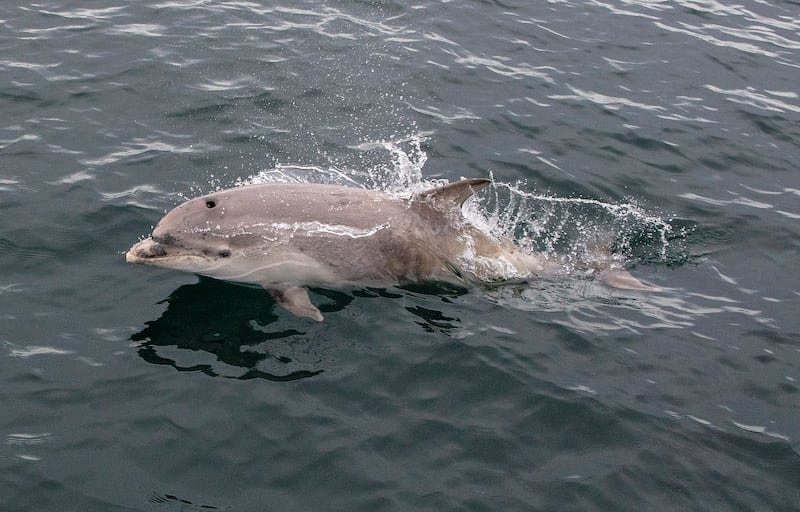
It’s £12 (€14) return as a foot passenger on the roll-on roll-off ferry that regularly travels these 10km. As it happens, I am the sole passenger on this ferry, and there no vehicles on board. The busiest time for tourists to come on to the island is in the morning.
4.40 pm
The ferry docks at the harbour’s Pier Two, in Church Bay; a semi-circle of seafront houses, sandy beach, a small marina and the National Trust-owned Manor House, where I’m staying for the next two nights. There are nine rooms currently open for guests.
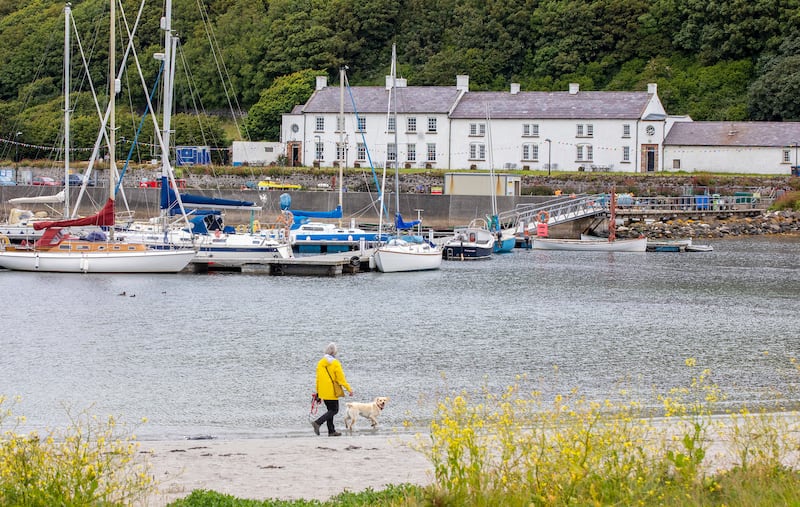
Mine is room 8, a small single with a big view out over the harbour. It’s £170 (€198) for two nights, with breakfast. I had booked weeks in advance. The Manor House is a lovely place, with plenty of charm, and an outstandingly beautiful piece of craftsmanship in the carved newel posts of the guesthouse staircase.
A Dublin scam: After more than 10 years in New York, nothing like this had ever happened to me
Poet Grace Wilentz: ‘Ireland has been very generous to me. There’s an abundance of fresh air and bookstores and intellectual stimulation’
The top 25 women’s sporting moments of the year: top spot revealed with Katie Taylor, Rhasidat Adeleke and Kellie Harrington featuring
Former Tory minister Steve Baker: ‘Ireland has been treated badly by the UK. It’s f**king shaming’
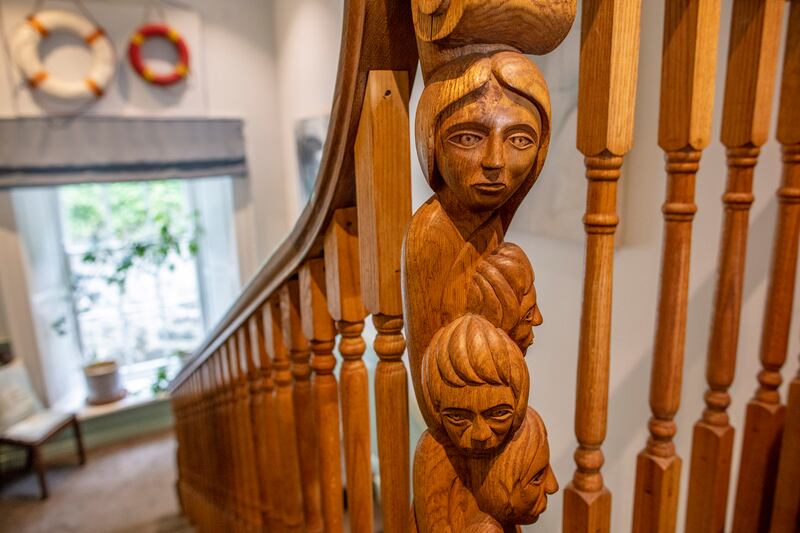
Four newel posts, carved with wood from a salvaged ship, depict the story of the Children of Lir; all carved by local resident, Paddy Burns.
5.45pm
Nicky Sebastian lives a few doors down, and is the author of the excellent Eight Walks on Rathlin Island, among other books. The illustrated walking guide book is usefully divided into eight separate sections, so you need to bring only the one you need with you on your walk.
“I came here from the Isle of Wight 20 years ago,” she says.
Sebastian’s life story is in her names. She was named Rachel by her Belfast-born birth mother, who went to England during the second World War to have her, and subsequently give her up. In the same hospital, another mother had just lost her own daughter shortly after birth. Baby ‘Rachel’ left the hospital with this recently bereaved mother, and the new name of Marigold. “I don’t think there was any official adoption,” Sebastian says.
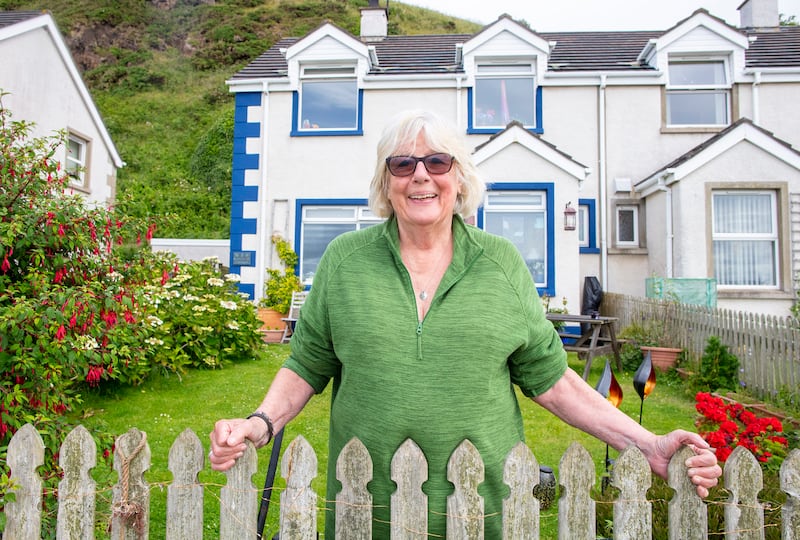
Where did the name Nicky come from? “I was nursing, and you couldn’t be called Marigold on the ward. I was a bit of a Beatnik, so the name Nicky stuck, since I was a teenager.”
Sebastian, who worked for the BBC as a massage therapist, preventing repetitive strain injury (RSI), until retirement, first came to Rathlin when visiting a friend in Ballycastle. She loved it immediately.
“We rocked up,” as she puts it. “And went for a walk. There were some houses being built, and I said to one of the young lads building them, are they for sale, and can I look at them.”
They were, and she could. Thus Sebastian sold up on the Isle of Wight, and went on to buy her three-bedroom house for £110,000 (€130,000) on the harbour front without having spent even one overnight on the island that was now going to be her home.
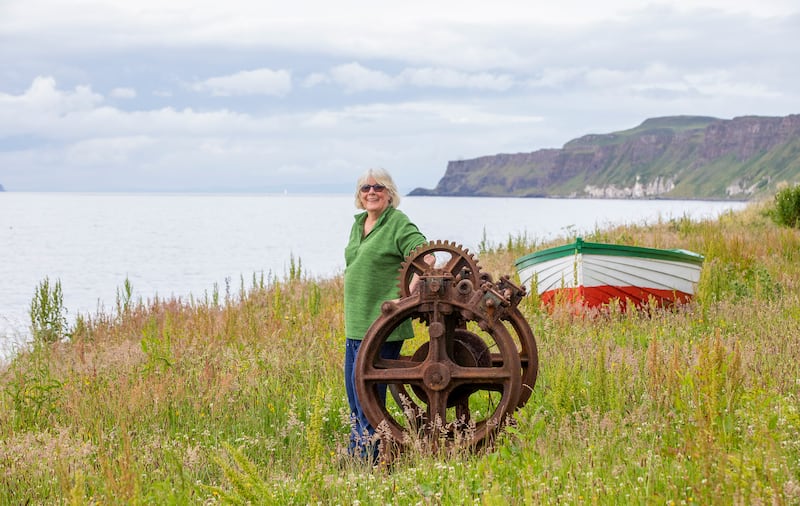
“I like the life here, it is so beautiful. There is no crime,” she says. When Sebastian came here, the island’s population was “about 68” and now it is about 145. The building of the new slipway, and the addition of the roll-on roll-off ferry, made island living far more viable, and helped to increase the population. More houses have now been built and a small social housing project is shortly to begin construction.
Sebastian says the biggest change she has noticed in her 20 years is how much fewer social gatherings there are now, and not just because of the pandemic. “When I came first, there was something on almost every night. Céilí, whist, boat races. You would hardly have any time to do anything at home. It’s different now. There is much less community activity. I put it down to people preferring to spend time on their screens.”
8pm
With fewer staff on site, Manor House guests are asked to submit their dinner and breakfast orders in advance. Given I can literally see the Atlantic Ocean out the window, the menu is surprisingly lacking in shellfish of any kind: no crab, lobster, mussels or oysters.
I order hake, whose provenance is not listed. Later, I email manager Mary O’Driscoll, who lives between Cape Clear island in Co Cork, and Ballycastle, to ask about the lack of shellfish.
“Because it [lobster] can be quite costly, it is usually an option for special occasions and not on our everyday menu. We sometimes have crab also but its shelf life is short… so shelling and cooking small quantities doesn’t make sense. We have a fishmonger of renown in Ballycastle so I’m sure he returns to us the Rathlin fish but washed, gutted, and oven ready,” is her reply.
However, to me – and other guests – it seems a missed opportunity; deliberately choosing not to put any shellfish on the menu of an island restaurant.
Monday
6am
I’m up early to talk to fisherman Benjy McFaul, before he takes his boat, the distinctive yellow-roofed Celtic Mor, out at 7am with his crew of two. We sit in his van at the harbourside to escape the rain. “My father’s side of the family has been here since at least 1740,” he says.
McFaul grew up on the island, He’s 40 now. “From when I was four to up to about 10, we had no electricity on the island,” he says. “We had a generator, which started in the evenings, and was very noisy.”
After electricity came, the harbour started to be developed. With the new ferry, building materials and other cargo can now be brought across much more easily, and more people have come to live on the island. “There are 17 children in the primary school now; the most since I was a kid.”
McFaul has been working as a fisherman since he left school at 16. He fishes for crab and lobster. He and his crew winch up some 400 pots a day. They’re off the dock about 7am, and not back till 6pm, 7pm, 8pm – however long it takes. They work two tide cycles.
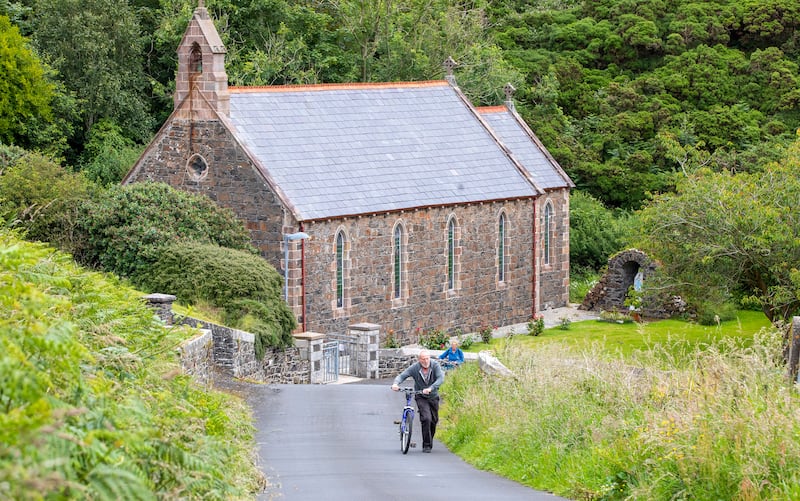
The previous day, they pulled in 260 kilos of crabs (youngsters are always returned), and about a box of lobster. “A good sized crab is a kilo.” They are stored live at sea, in special cages, waiting for the buyer’s order to come in.
McFaul isn’t keen to get into detail about his buyer, but he does tell me almost everything he catches is exported, although not to where.
10am
After breakfast, I sit down with fellow guest Eamonn Keenan from Belfast. He is visiting with 16 family members. Some are in the Manor House, the rest are staying in the four glamping pods beyond the beach.
“I came to Rathlin first 40 years ago,” he tells me. “It was a very noisy place at night back then, with all the generators going. I came over on my own with my tent. There used to be a field where you could camp, near the old pub,” Keenan laughs. “I had a good night in the pub.”
The result of his good night in the pub was that he missed the only return ferry off the island the next day that ran back then. A family in a boat offered him passage that afternoon back to the mainland, as long as he didn’t mind them fishing along the way. He didn’t.
“There were two girls and their parents, and they stopped to fish something for their tea – mackerel, I think – and then the two wee girls starting singing to me, and it was just magical.”
Ever since then, Keenan has returned with his family at least once a year.
11.40am
I have paid a fiver to board Bert’s Puffin Bus; a slightly ramshackle minibus that is driven by a man who is not Bert. Bert, I’m told, is now retired. The Puffin Bus meets the ferries, and shuttles passengers to the West Lighthouse (Rathlin has three), where the Seabird Centre lies.
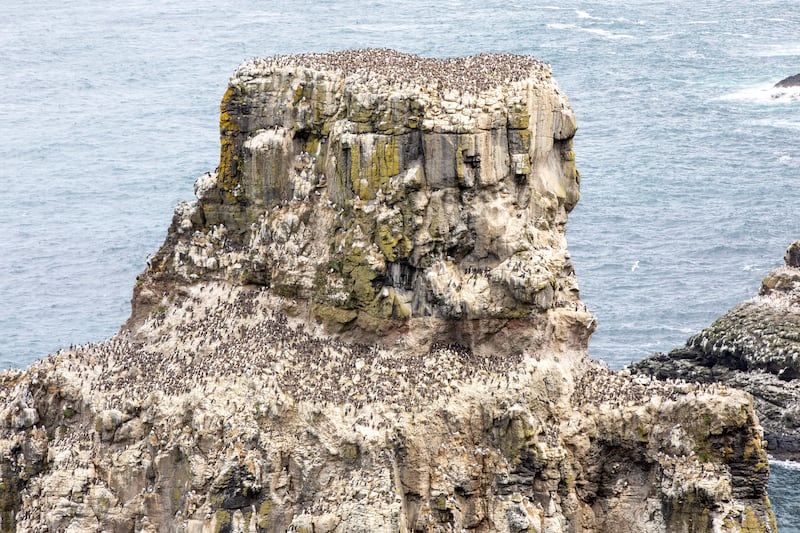
It’s a 14km round trip and, although I’d like to walk, I’m short on time. The road is elevated and we are taken through the most gorgeous scenery, most of it empty of any buildings. The views out over the ocean are fabulous.
The man who isn’t Bert says he’ll be back in an hour to collect us. There is a little centre run by the Royal Society for the Protection of Birds (RSPB), where I spend another fiver on an entrance ticket.
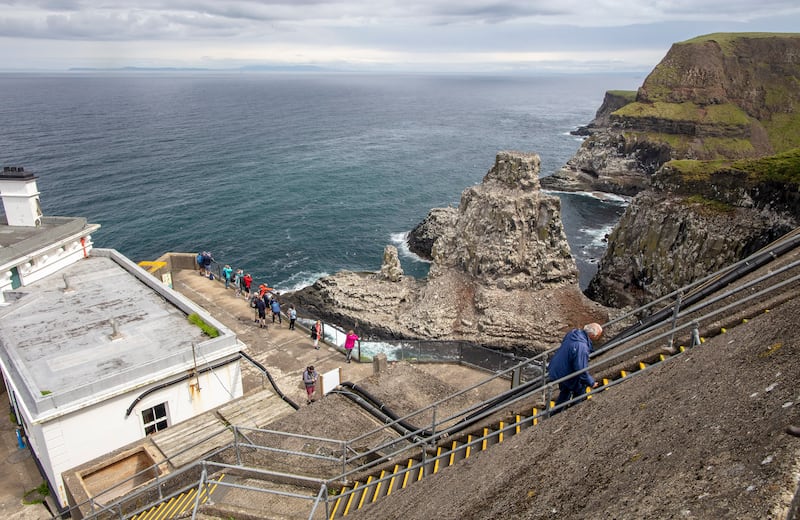
This part of Rathlin is perched high above its western cliffs and sea stacks, that rise from the ocean like jagged castles. There is a path and steps that take us around the headland, and past the lighthouse, currently closed for renovations. I step out on to the viewing platform and what I see is a world-class view of some quarter million seabirds, swooping and crying, and nesting and flying, in and around and above fantastically magnificent cliffs.
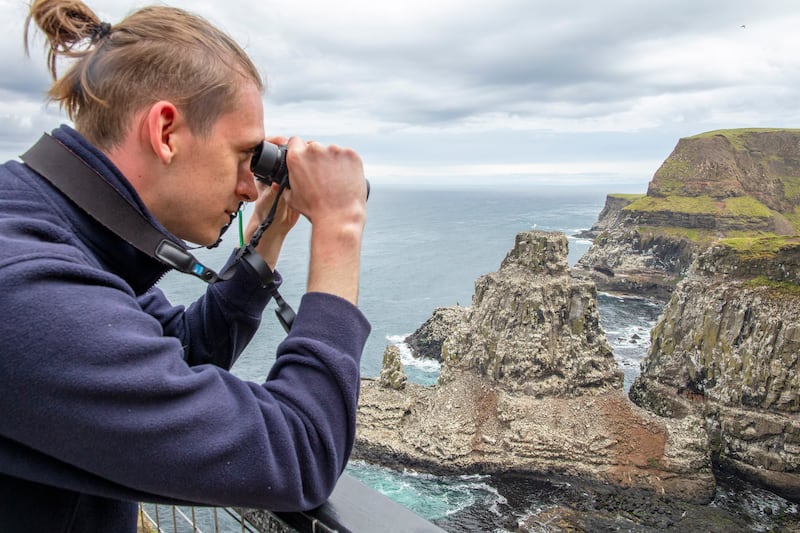
There are guillemots – the largest colony, at 150,000 – fulmars, razorbills, puffins and some stray visitors, such as a pair of Great Black Backed Gulls, who came to nest on stones far below us, and who have two chicks.
I know all this because Rebecca Tanner, one of the extremely knowledgeable RSPB employees, tells me. The on-site staff hand out binoculars to everyone. It’s staggering to see so many seabirds so close by, and in such detail. I am absolutely enthralled: it is an astonishing experience.
There is a telescope on the platform too, and Tanner adjusts it, and invites me to look. I look. I’m looking at a guillemot chick, who appears to be attached to a literal cliff edge by some magical avian glue, being fed tiny fish by one parent, while the other bird parent fusses over it. The trio are literally millimetres away from the edge. The fledging can’t yet fly.
How does he not fall off, I ask.
“I guess the motivation to cling to the cliff is high,” Tanner replies.
12.40pm
I’m back at the harbour, foraging for lunch. The Watershed Cafe doesn’t open on Mondays. There’s the Hungry Seal takeaway, but I’m not hungry for fast food. The Manor House Food Hut is not serving food this week. My only other option is the island’s co-op shop, where I get a chicken wrap with Rathlin Island kelp pesto for £4.25. Ironically, the shop shuts 1pm-2pm for lunch. An enterprising person with some culinary experience/ambition could surely fill this gaping hospitality gap during summer months? Tourists keep coming in to the Manor House reception, where I’m sitting with my wrap post 1pm, asking in dismay where they can find something to eat.
3.30pm
The Boathouse Visitor Information Centre is both the tourist office and a very well laid out little museum, showcasing the island’s history. There are also some unusual souvenirs, including a charming felted puffin for £45 (€53), exquisitely handmade by Shelley Steele of Ballymena. There was a golden hare by her too, but that’s been sold, Hazel Watson tells me, who is behind the counter.
A golden hare? “They are special to Rathlin,” Watson says. “Red fur and blue eyes.” I immediately long to see a golden hare.
5pm
Artist Yvonne Braithwaite has just closed up her Breakwater Studio gallery and craft shop for the day. Originally from Co Down, she first came to Rathlin nine years ago on a day trip. She went to the Seabird Centre, and then walked back to the harbour, and sat in the little church there for a time. “I felt so at peace” is how she describes her feelings that day.

“I had always wanted to be an artist on an island.” She passed the building that is now Breakwater Studio, but was then “breeze blocks”. She took a chance, bought the place, finished it, and now literally lives above the shop, with a view out over the ocean. “I paint in the winter, and sell in the summer.”
7pm
I walk the 20 minutes or so uphill towards Margaret McQuilkan’s B&B, called Coolnagrock. I’m not sure of the directions, and stop at a house to ask. The man who wasn’t Bert, who drove Bert’s Puffin Bus this morning, answers the door, and directs me onwards. I feel it is now too late to ask his name.
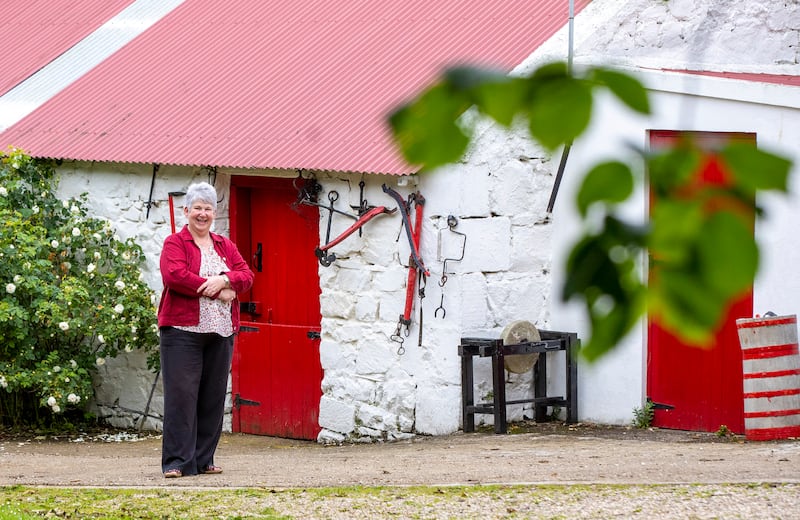
McQuilkan’s home is in yet another gorgeous location, perched on a hill that overlooks Scotland from one side, and Ireland from the other. It is the only B&B open on the island and, as it happens, she will be closing permanently at the end of July, so there will be even less accommodation then. “I’ve been running it for 21 years, and now it’s time to stop,” she tells me. We’re sitting in her conservatory, which has spectacular views, and where lucky guests have eaten their scenic breakfasts for two decades.
A double costs £90 (€106), and she has three rooms, but most guests stay only a night. “It is a lot of work.”
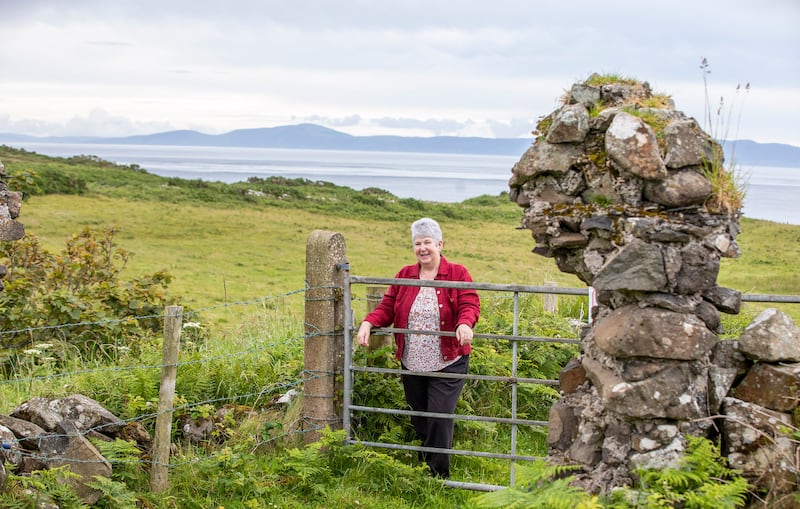
McQuilkan’s late father, Loughie, was a storyteller, whose aural history of the island can be found in the book Rathlin Reminiscences. I had seen a copy earlier that day, and his forensic knowledge of Rathlin people and places was remarkable: the book is a true legacy.
The house where we are talking was built in 1999. Back then, McQuilkan tells, me, due to Northern Ireland building rules, the former family home on the land first had to be demolished. She is still upset when she relates this story to me. “Even today when I dream, I dream I am in the old house,” she says.
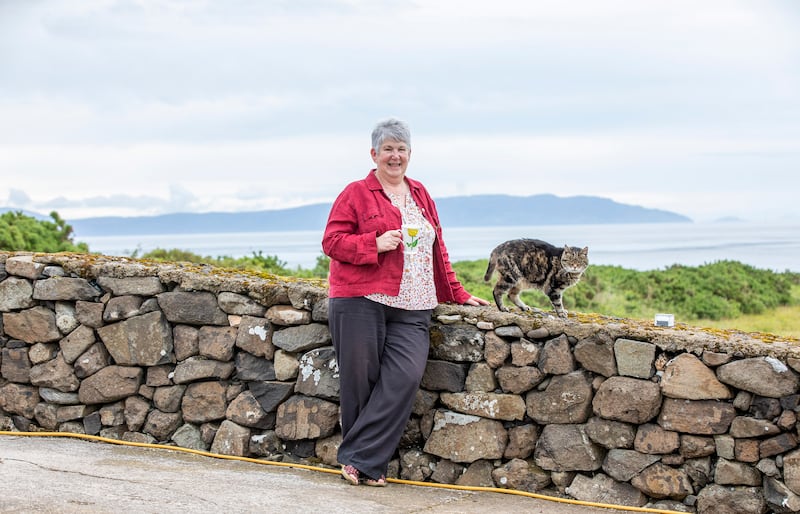
When I am leaving, she walks out with me, and tells me there was a golden hare all evening in the opposite field. We look together but, sadly, the hare has now vanished from sight.
I walk back to the Manor House in the drizzle, inhaling the smell of ocean and damp green fields.
Before falling asleep to the sound of the waves that night, I think of the guillemot chick, and hope he is still safely on that precipitous cliff side, guarded on either side by both parents.




